Part 2: The journey of a star map from deinstallation to storage
Continue the journey of multimedia artwork ‘Stargazing’ (2022) by artist Sarah Spencer, as it comes off display at the conclusion of the Library’s exhibition Handmade Universe, and the Collection Care team prepare it for storage – including how best to manage the artwork’s distinctive digital and technological components. To read about how the artwork came to be and the exhibition installation process, read Part 1 of this series.
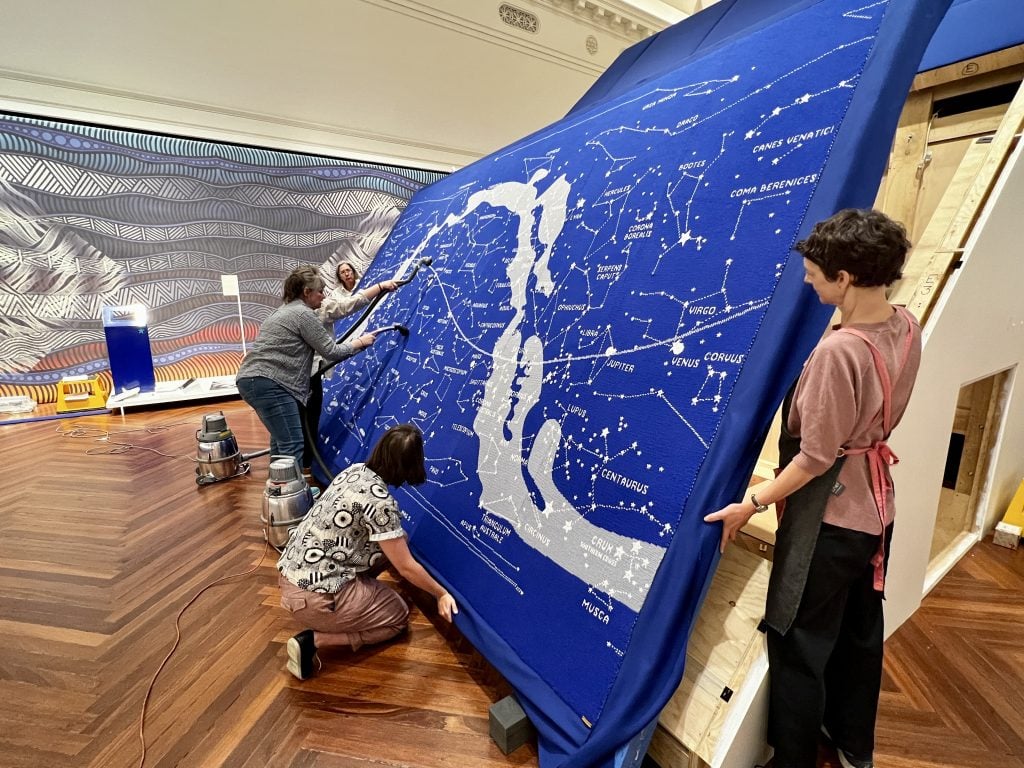
Collection Care staff vacuuming the knitted layer of ‘Stargazing’. Image credit: Jessye Wdowin-McGregor.
A blanket for the stars
Before ‘Stargazing’ was removed from display, a visual inspection took place to identify any areas that may have been damaged during the eight-month exhibition period. Along the lower edge of the artwork, the loss of several light wells, some strain on areas of hand sewing, and LEDs no longer lighting up were observed and documented. These issues were consistent with an area of the knitted woollen star map that was more vulnerable to being handled or inadvertently leant on while on display.
Next, the artwork was manoeuvred out of the exhibition mount, with staff supporting it both from inside the void at the back as well as from the front. Lowering the artwork onto chocks on the floor facilitated a gentle vacuum of the central area, removing dust that may have settled on the artwork. Dust can become embedded in textile fibres over time and may lead to physical degradation through the abrasion of fibres. The artwork was then positioned atop a large, soft ‘wedge’ designed to be a seat for visitors to view ‘Stargazing’ during the exhibition.
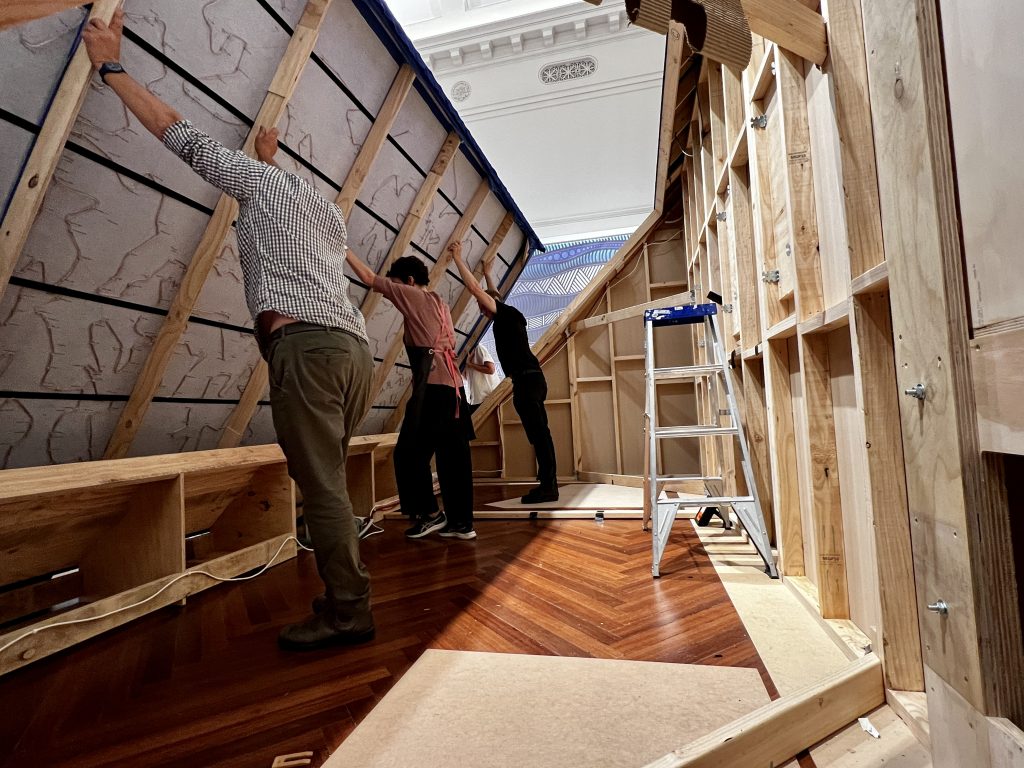
Members of the deinstall team support ‘Stargazing’ from the void inside the exhibition mount, as it is lowered to the floor. Image credit: Jessye Wdowin-McGregor.

Once lowered, vacuuming of the central area of the knitted layer takes place. The artwork continues to be supported from behind and at the sides. Image credits: Jessye Wdowin-McGregor.
In this position, the edges of the artwork were vacuumed, and a portable light was passed over the knitted layer to better locate any evidence of insect activity or damage. Insects are also a cause for concern – particularly for naturally occurring materials like wool, which are an attractive protein-based food source. Even within the controlled conditions of the Library, two carpet beetle larvae were spotted on the knitted layer of ‘Stargazing’, which prompted the artwork to undergo a preventive pest treatment, detailed later.
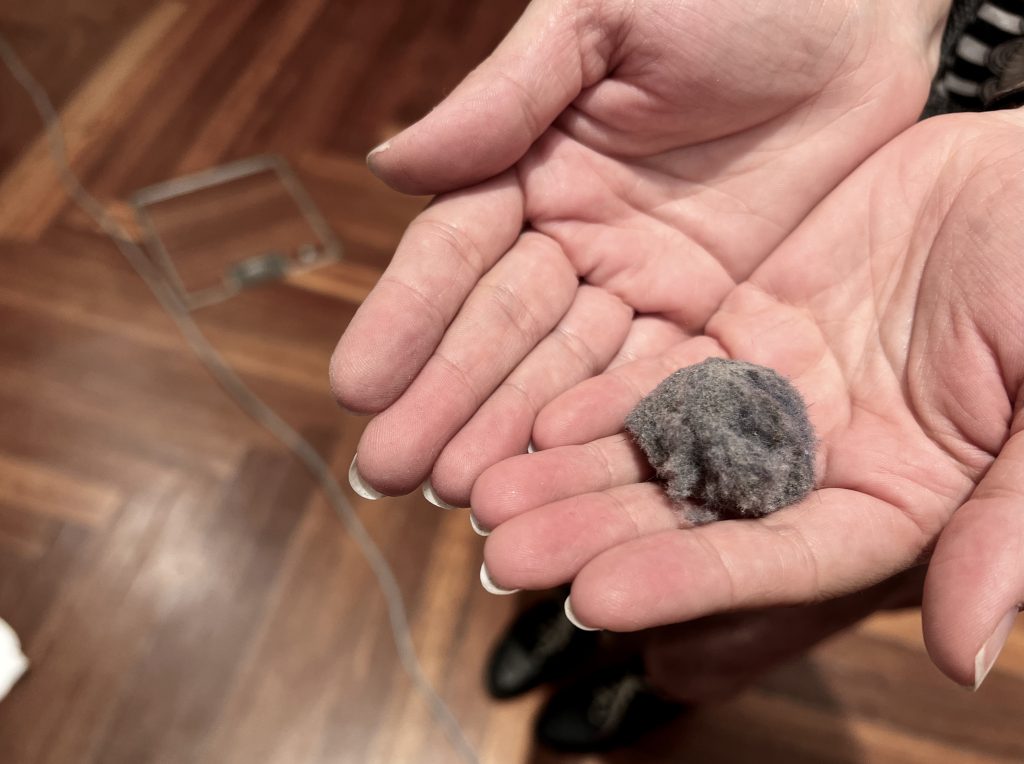
Example of the amount of dust vacuumed from the edges of the knitted layer of the artwork. Image credit: Jessye Wdowin-McGregor.
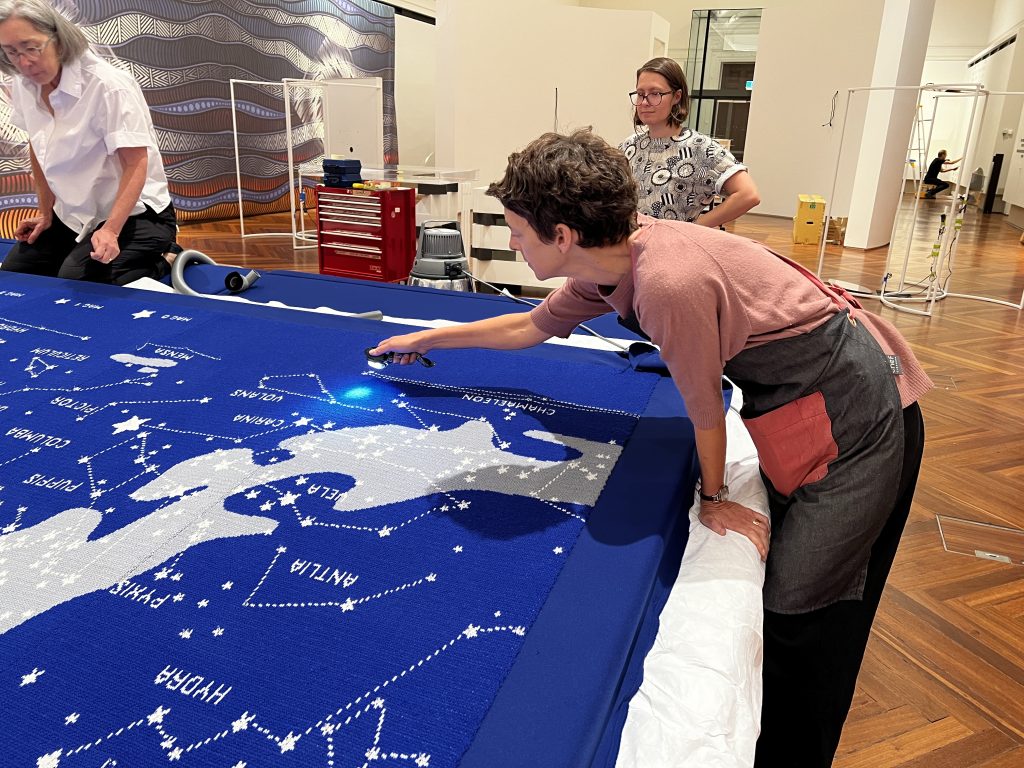
Moving a portable light over the knitted layer to locate any insect damage that may have occurred during the display period. Image credits: Jessye Wdowin-McGregor.
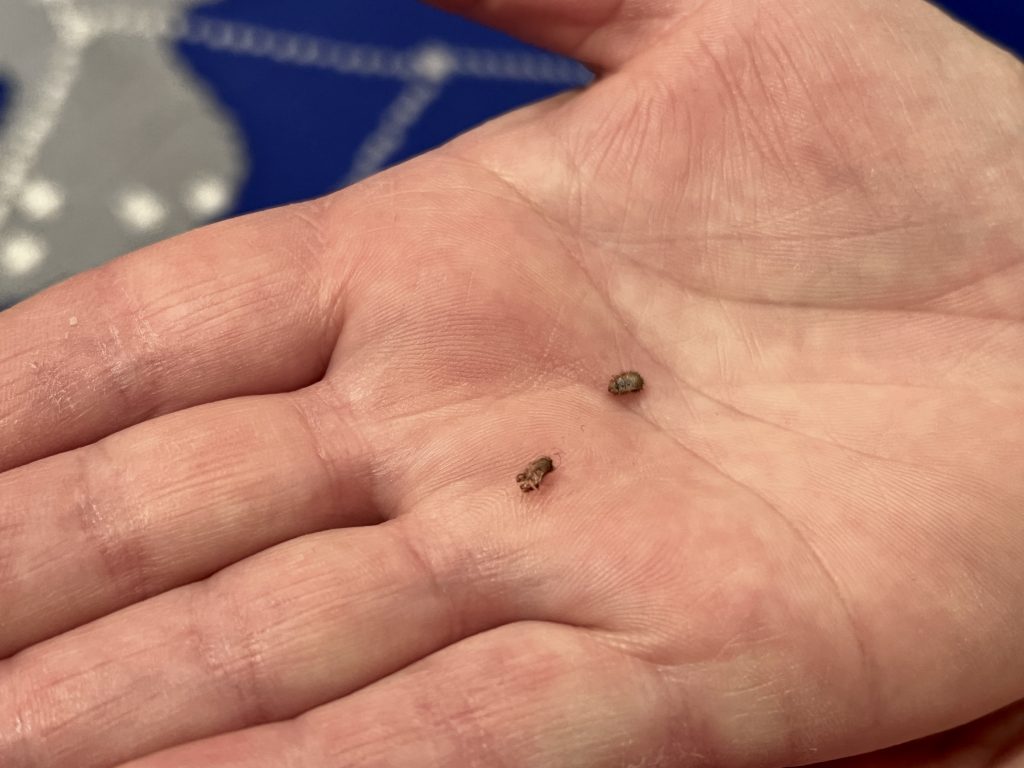
Two carpet beetle larvae removed from the knitted layer. Image credit: Jessye Wdowin-McGregor.
The artwork was released from its wooden support frame before a padded interleaving layer of white cotton jersey and Dacron batting was aligned atop the knitted layer. This snug ‘blanket’ offers extra protection to the fragile light wells which protrude from the constellations on the knitted layer (see Part 1 for details). ‘Stargazing’ was then carefully and slowly rolled around a large hollow tube lined with Preservation Foil, which acts as a barrier layer between the tube surface and the artwork.
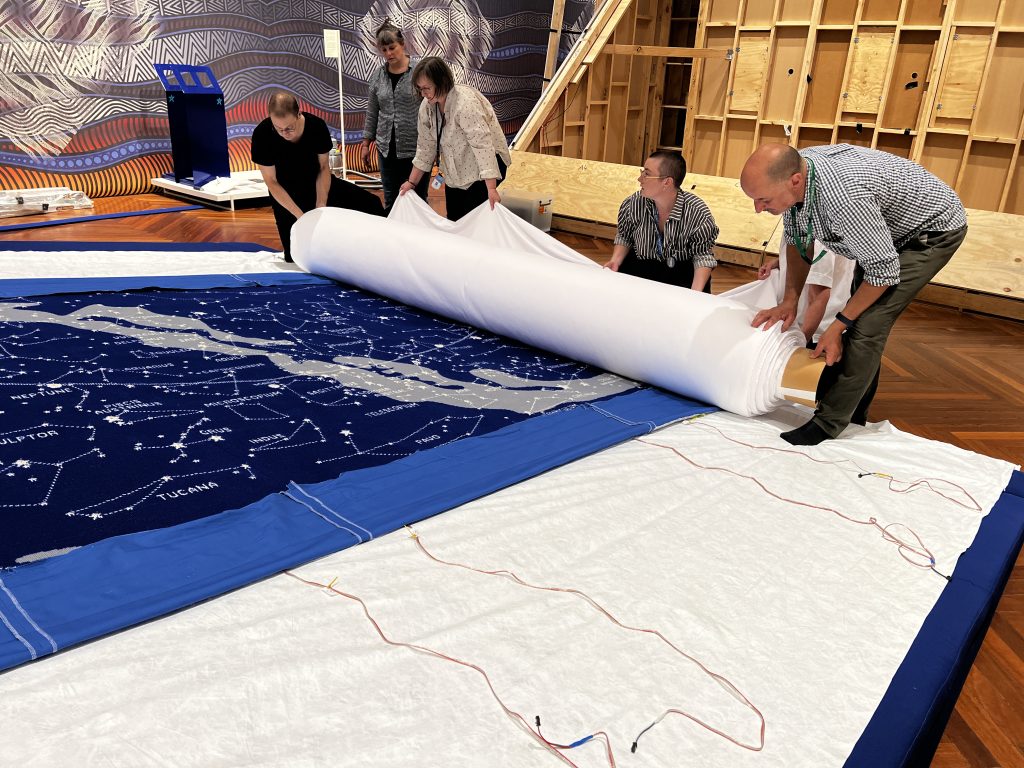
The padded interleaving layer is aligned atop ‘Stargazing’ and rolled across the knitted layer. Image credit: Jessye Wdowin-McGregor.

Tension is maintained by holding the padded interleaving in place at one end. Image credit: Jessye Wdowin-McGregor.
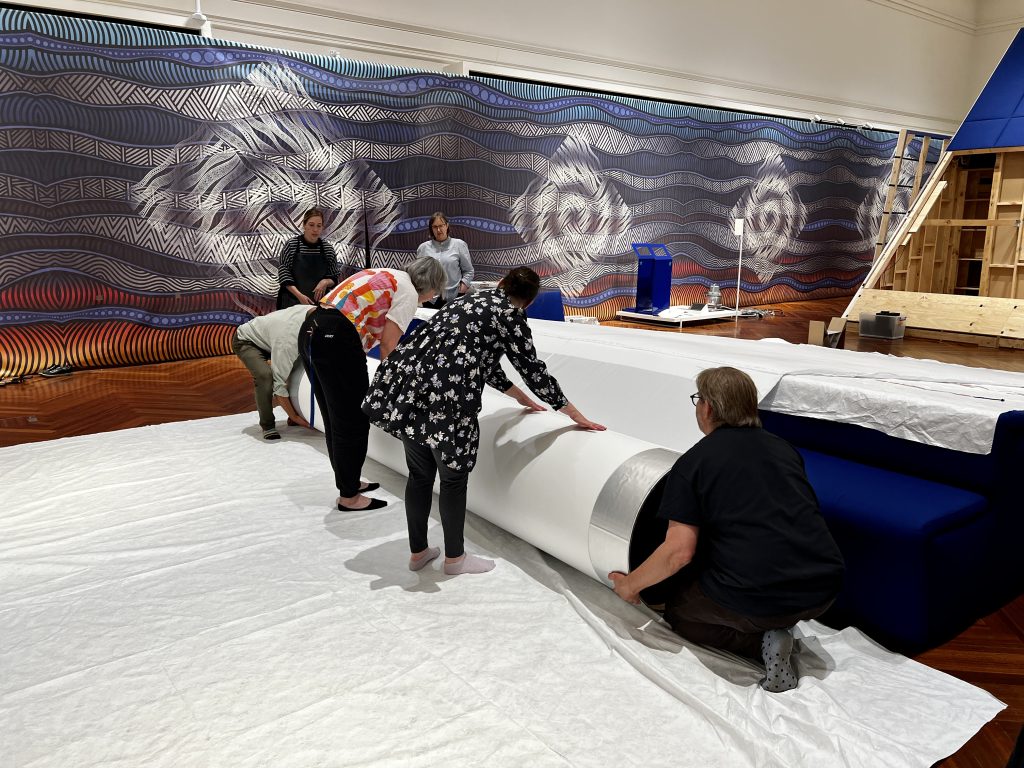
Large hollow tube lined with Preservation Foil is positioned at one end of the artwork, in preparation for rolling. Image credit: Jessye Wdowin-McGregor.

Rolling process commences; the alignment of the padded interleaving layer and the artwork on the tube are monitored. Image credit: Jessye Wdowin-McGregor.
Exiting the building (momentarily)!
The artwork was wrapped in a final sheet of Tyvek, to protect the exposed underlay with LED wiring. ‘Stargazing’ was then ready to leave the gallery and be relocated to a temporary storage space. An important consideration for any oversized object in the Library’s collection is planning how to safely move it around the building and whether it will fit through the doors, corridors, stairwells, and lifts! Although only a floor below the gallery, for the artwork to reach the temporary storage space, it needed to be transported around the outside of the Library and into the loading dock area – at 3.7m long in its rolled form, ‘Stargazing’ is too large to be taken into the lifts or manoeuvred up and down the stairwells.
Secured atop two curved trolleys, the artwork was carefully transported through several public areas of the Library, then outside onto La Trobe Street and along Russel Street, before finally turning into Little Lonsdale Street, where it was guided into the loading dock. Access via a hydraulic lift enabled the artwork to be moved inside the Library and directly to the exhibitions store. It was here that ‘Stargazing’ was placed inside a large custom-built wooden crate, ready for the next stage of its journey.

Wrapped in Tyvek, the artwork is secured atop two curved trolleys. Images credit: Jessye Wdowin-McGregor.
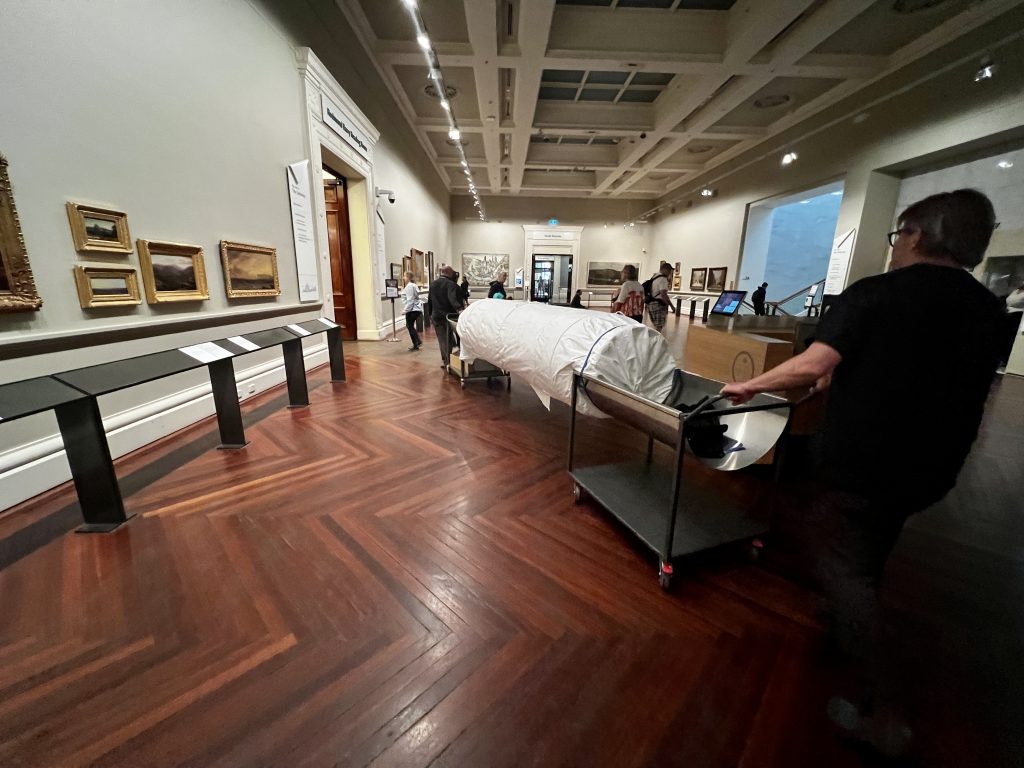
‘Stargazing’ is transported through the Redmond Barry Reading Room. Image credit: Jessye Wdowin-McGregor.
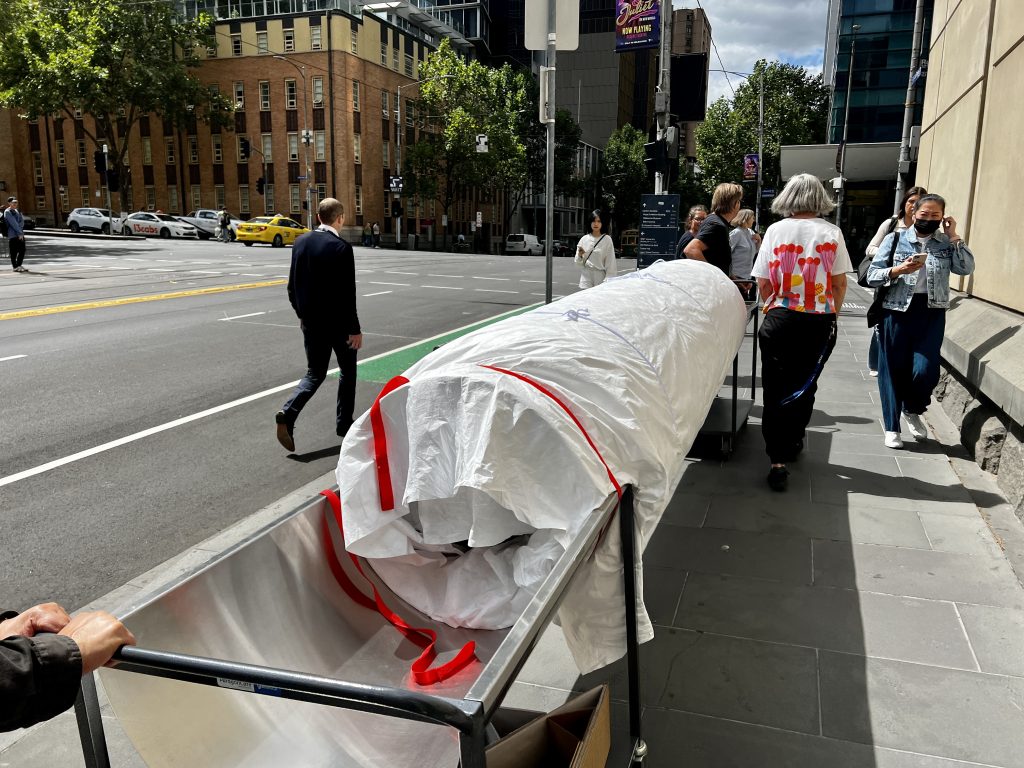
Travelling outside the building along La Trobe Street. Image credit: Jessye Wdowin-McGregor.
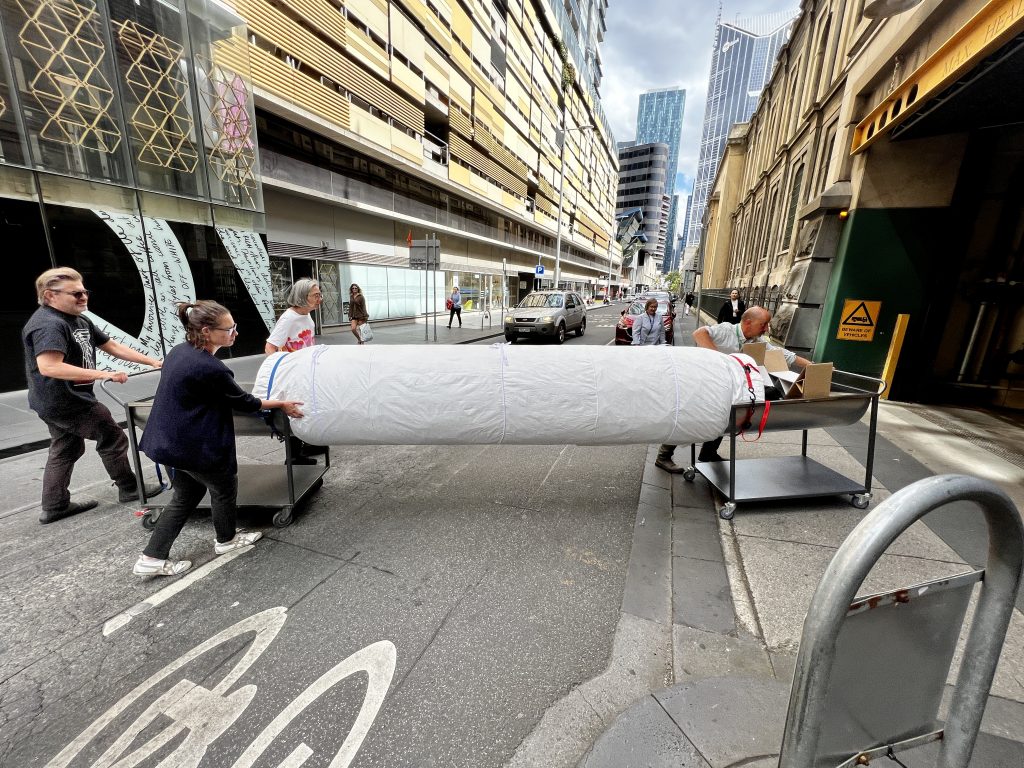
After waiting for a green pedestrian light on Little Lonsdale Street, ‘Stargazing’ is manoeuvred onto the road, to angle it into the loading dock. Image credit: Jessye Wdowin-McGregor.

‘Stargazing’ next to its custom-built crate. Image credit: Jane Hinwood.
To freeze or not to freeze?
Due to the discovery of carpet beetle larvae on the knitted map, there were concerns that other insects, eggs or larvae may have been present but undetectable, hidden in parts of the map that are inaccessible or invisible to the human eye. As part of our work in Collection Care, a non-toxic low temperature treatment is routinely applied to pest-affected items that can safely withstand freezing temperatures. This involves carefully double-bagging dry objects in air-tight plastic and freezing at -20˚C for at least three weeks – a temperature cooler than most insects can survive and for long enough to disrupt their life cycle.
There are several factors to consider when undertaking this type of treatment, including what an object is made of (some materials can be damaged at low temperatures), the scale and complexity of an object, and objects comprising multiple material types that may be affected differently. For ‘Stargazing’, the main considerations were accessing a freezer large enough to fit the artwork inside, and whether freezing could adversely affect the adhesive bond between the light wells, the eyelets and the LED lights, an already fragile component of the artwork. Of three adhesives present, only one presented a minimal risk of failure and was used sparingly.
A low-oxygen or anoxic treatment was also considered as an alternative option. However, while this treatment may pose less of a risk to the adhesive properties of the artwork, it is challenging to get right at scale, requires access to specialist equipment, and is considerably more expensive without the required setup already in place.
Drawing on the Library’s professional relationship with Museum Victoria, ‘Stargazing’ was transported to the Museum’s commercial walk-in freezer, which is large enough to accommodate oversized objects, such as taxidermy lions! It was frozen for three weeks before journeying to the Library’s offsite collection storage centre.
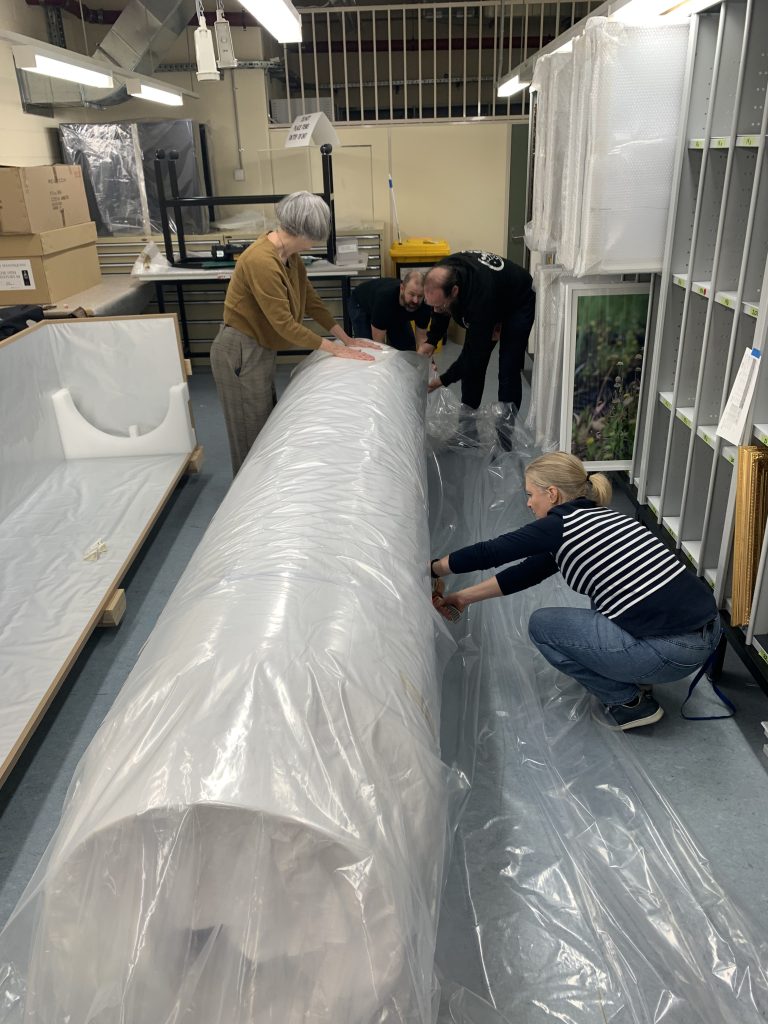
Wrapping ‘Stargazing’ in plastic, in preparation for low temperature treatment. Image credit: Leah Williams.
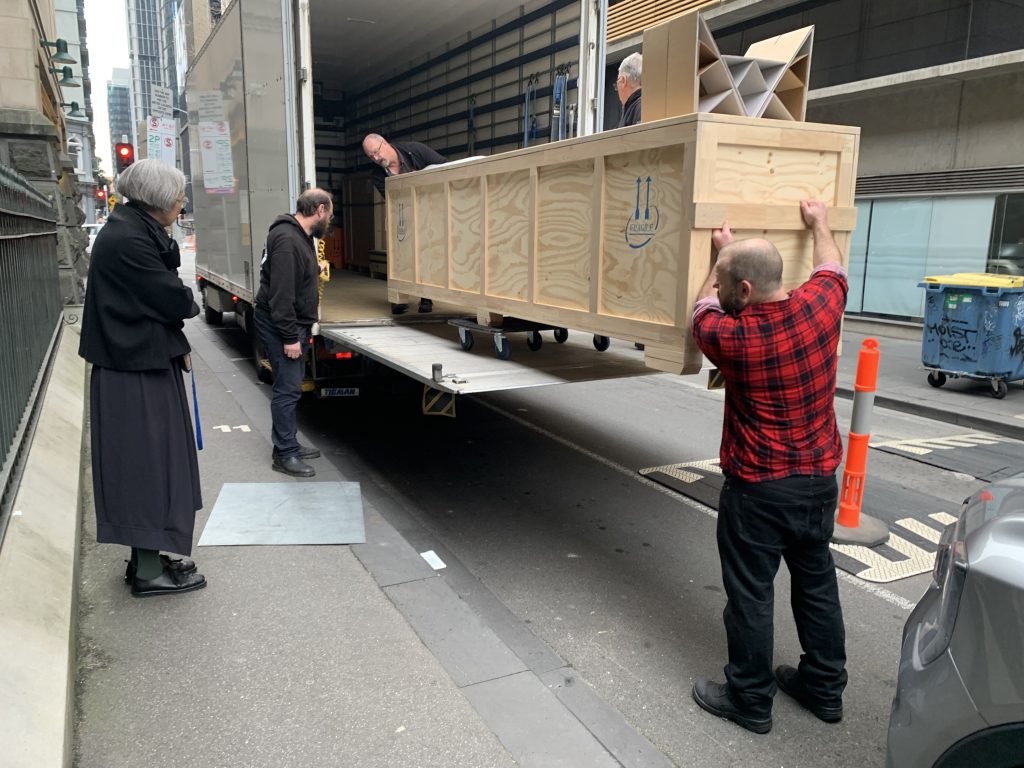
‘Stargazing’ inside its custom crate, being loaded onto a truck by the loading dock at the Library. Image credit: Leah Williams.
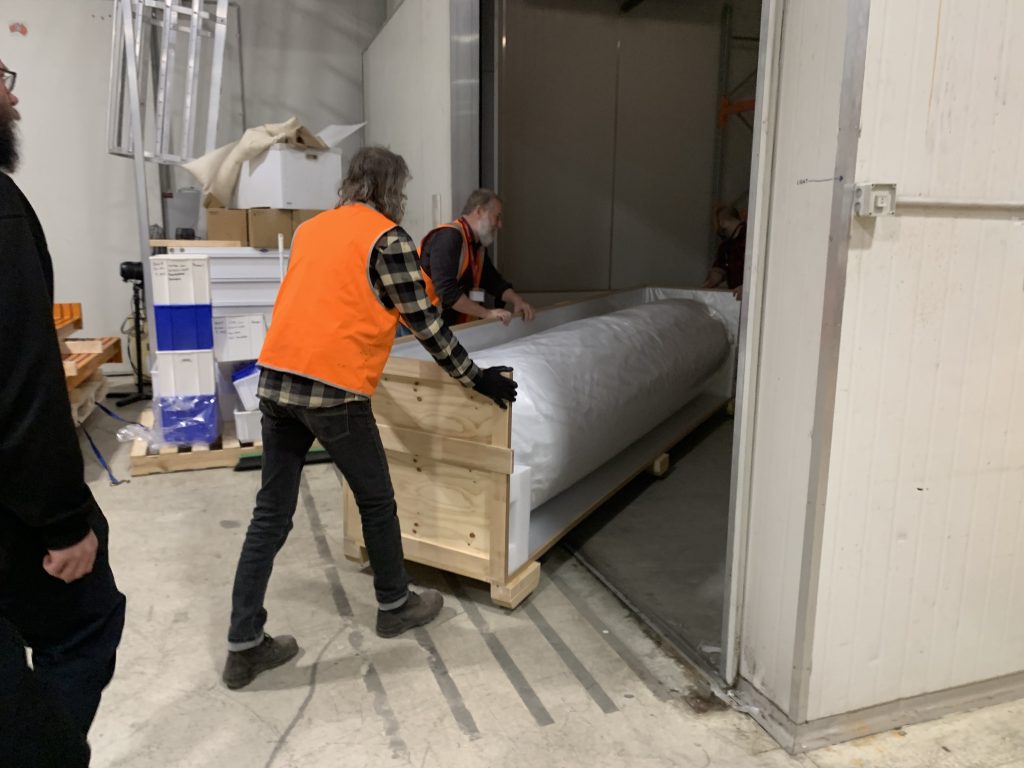
‘Stargazing’ is manoeuvred into Museum Victoria’s walk-in freezer. Image credit: Leah Williams.
Beyond the material
As an artwork that only comes to life once installed and interacted with, ‘Stargazing’ requires different conservation and collection management practices to ensure its longevity and accessibility. Unlike more traditional collection objects, time-based media artworks are at risk of becoming inaccessible through rapid software, file, and hardware obsolescence. If left unchecked, this type of loss can remain disquietingly invisible until the work is revisited for display or access.
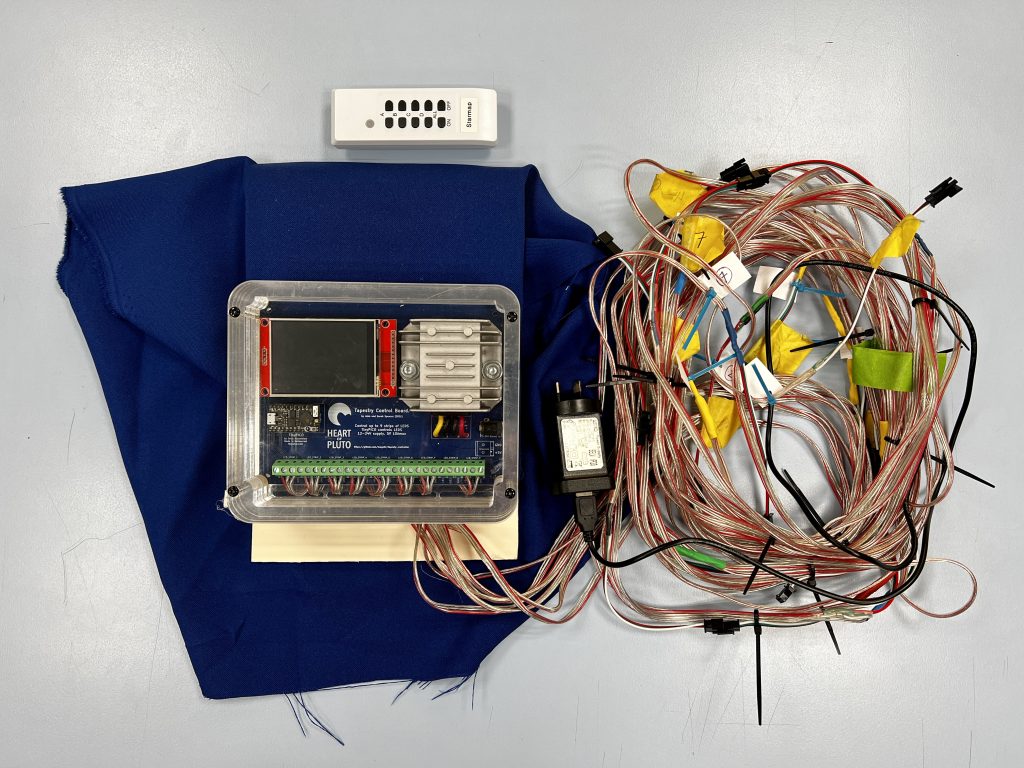
View of one of two circuit board / development boards with wires and power adaptor, that form a key part of ‘Stargazing’. The circuit board / development boards speak to an app designed by the artist, which was loaded onto two iPads included in the installation of the artwork during the exhibition. Image credit: Jessye Wdowin-McGregor.
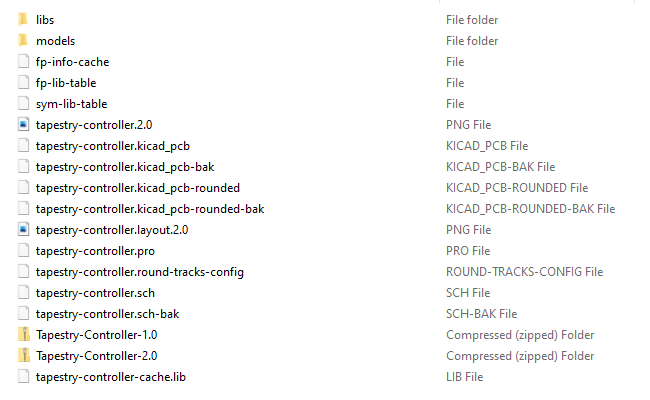
Screenshot of circuit board / development board design files provided by the artist. Image credit: Jessye Wdowin-McGregor.
Thorough documentation has been a critical part of the preservation framework for the Library’s first time-based media artwork. As well as recording physical features like the materials used to make the artwork, the overall trajectory of ‘Stargazing’ has also been captured. This includes often-undocumented aspects, such as challenges encountered and decision-making during the installation and deinstallation process. A video record of the elements unique to the moment of display, like the experiential and interactive nature of the artwork, further adds to the documentation.

Stills from an instructional video capturing ‘Stargazing’ while on display, including interaction with one of two iPad tablets that formed part of the installation. Visitors were able trace their own constellations on an iPad and light up the stars in real time on the artwork. Image credit: Jim Arneman.
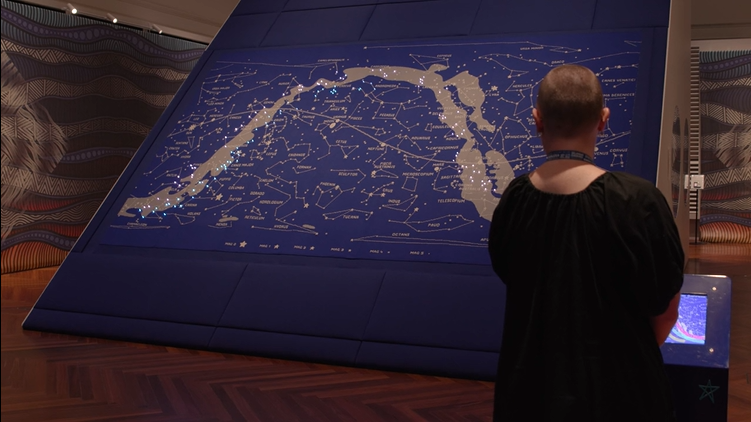
Stills from an instructional video capturing ‘Stargazing’ while on display, including a constellation lighting up after it was traced out on the iPad. Image credit: Jim Arneman.
In addition, an artist questionnaire was provided to Sarah Spencer, designed to gather detailed technical and equipment specifications related to the artwork, devised by our Senior Digital Preservation Specialist in the Collection Development and Description team. It is hoped this will assist with long-term conservation decisions related to obsolescence and transmission of the artwork’s digital components over time. The questionnaire also aims to understand the artist’s intentions as they relate to future presentations of the artwork and locating the parameters for acceptable changes or modifications.
From beginning to end, the process of acquiring, displaying, and preparing for the long-term care and future reactivation of ‘Stargazing’ has relied on the collaborative, multidisciplinary efforts of many teams across the Library. The generosity and involvement of the artist through each stage has also been integral. While management of the ephemeral qualities of ‘Stargazing’ remains a work in progress, the acquisition of a complex time-based media artwork has been an important test case for understanding the planning, resources, and specialist skill sets required to support the conservation needs of future works of this kind.
Acknowledgements
We thank the following organisations and individuals for the sharing of knowledge, expertise, and equipment:
National Gallery of Victoria for the loan of a moveable gantry during the exhibition installation stage and resources for roll storage of large objects
Catherine Shannon, freelance textiles specialist, for custom making the oversize, padded interleaving layer which protects the artwork during rolled storage
Museum Victoria for use of their freezer during the preventive treatment stage
National Museum of Australia for sharing their experiences and knowledge related to anoxic treatments (as a potential alternative to low temperature treatments)
Candice Cranmer, Time-based Media Art and AV Conservator at Australian Centre for the Moving Image, for her expertise related to preserving the digital components of ‘Stargazing’

